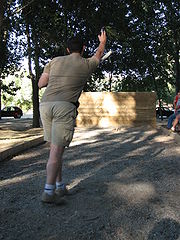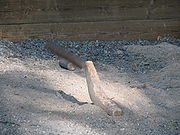
Calva
Encyclopedia

- The term "calva" is also sometimes used to refer to the Calvaria (skull)Calvaria (skull)The calvaria is the upper part of the cranium and surrounds the cranial cavity containing the brain.The calvaria is made up of the frontal, occipital and right and left parietals....
or Calvados (brandy)
Calva is a traditional sport played in certain parts of Spain
Spain
Spain , officially the Kingdom of Spain languages]] under the European Charter for Regional or Minority Languages. In each of these, Spain's official name is as follows:;;;;;;), is a country and member state of the European Union located in southwestern Europe on the Iberian Peninsula...
. It has roots going back to pre-Roman times, being developed by the Celtiberians
Celtiberians
The Celtiberians were Celtic-speaking people of the Iberian Peninsula in the final centuries BC. The group used the Celtic Celtiberian language.Archaeologically, the Celtiberians participated in the Hallstatt culture in what is now north-central Spain...
who lived in the modern-day provinces of Ávila
Ávila (province)
Ávila is a province of central-western Spain, in the southern part of the autonomous community of Castile and León. It is bordered on the south by the provinces of Toledo and Cáceres, on the west by Salamanca, on the north by Valladolid, and on the east by Segovia and Madrid. Ávila has a...
, Salamanca
Salamanca (province)
Salamanca is a province of western Spain, in the western part of the autonomous community of Castile and León. It is bordered by the provinces of Zamora, Valladolid, Ávila, and Cáceres; and by Portugal....
, and Zamora
Zamora (province)
Zamora is a Spanish province of western Spain, in the western part of the autonomous community of Castile and León.The present-day province of Zamora province was one of three provinces formed from the former Kingdom of León in 1833, when Spain was re-organised into 49 provinces.It is bordered by...
. It was a game for shepherds, who threw stones at bull's horns to entertain themselves. With the passing of time, the game was modified: a piece of wood (the calva) came to be substituted for the horn, and the stone was replaced with a cylinder of iron or steel (the marro). The name of calva was derived from the field in which the game came to be played, which was free of obstacles and rocks.
Today the sport is practiced mainly in Castile
Castile (historical region)
A former kingdom, Castile gradually merged with its neighbours to become the Crown of Castile and later the Kingdom of Spain when united with the Crown of Aragon and the Kingdom of Navarre...
, Salamanca
Salamanca
Salamanca is a city in western Spain, in the community of Castile and León. Because it is known for its beautiful buildings and urban environment, the Old City was declared a UNESCO World Heritage Site in 1988. It is the most important university city in Spain and is known for its contributions to...
, Zamora, and Biscay
Biscay
Biscay is a province of Spain and a historical territory of the Basque Country, heir of the ancient Lord of Biscay. Its capital city is Bilbao...
, although also in Madrid
Madrid
Madrid is the capital and largest city of Spain. The population of the city is roughly 3.3 million and the entire population of the Madrid metropolitan area is calculated to be 6.271 million. It is the third largest city in the European Union, after London and Berlin, and its metropolitan...
, Barcelona
Barcelona
Barcelona is the second largest city in Spain after Madrid, and the capital of Catalonia, with a population of 1,621,537 within its administrative limits on a land area of...
, and Plasencia
Plasencia
Plasencia is a walled market city in the province of Cáceres, Extremadura, Western Spain. , it had a population of 41,447.Situated on the bank of the Jerte River, Plasencia has a historic quarter that is a consequence of the city's strategic location along the Silver Route, or Ruta de la Plata...
.
The game

The calva is generally made of oak
Oak
An oak is a tree or shrub in the genus Quercus , of which about 600 species exist. "Oak" may also appear in the names of species in related genera, notably Lithocarpus...
and has the form of an obtuse angle, between 110 and 120 degrees. The lower part, called the zapata, has a length of 23 cm, while the upper part (the alzada) is 22 cm long.
The marro was originally often a rock taken from a creekbed, where it had been worn smooth. Today it is usually an iron cylinder or oval with the name of its owner, weight, length, etc. often inscribed on it. It cannot be greater than 25 cm in length and generally weighs between 2 and 3 kilograms.
The field of play is usually about 25 meters in length and about 5 meters in width. The distance of the throw is standardized at 14.5 meters, leaving about 3-5 meters for an approach area and 6-8 meters to stop the throw.

